More than once I’ve written here about the misconceptions I had about spirea. For a time it was, to me, the most boring of shrubs, the least interesting of what I call the “landscaper’s trio” of spirea, daylilies (almost always ‘Stella d’Oro’) and a (usually sickly looking) hydrangea. Somewhere along the line this combination became the standard planting along every foundation in every new subdivision here.
Even as a novice gardener I swore I’d never plant spirea, such was my disdain for this shrub.
One thing I’ve learned gardening is that I really need to stop swearing off plants. Without fail, I come back to them and eat my words.
There are several excellent spireas on the market these days, a testament to the wonders of plant breeding, which has changed it from a reliable but unnoteworthy shrub to a must-have garden shrub.
I’ve talked about Double Play Blue Kazoo here before and it continues to be at the top of my list, but few shrubs in my garden provide the kind of three-season interest I get from birchleaf spirea, specifically Proven Winners’ Glow Girl variety. There are other birchleaf spireas (look for a cultivar name that includes ‘Tor’) on the market that look equally lovely, I’ve just not had the opportunity to grow them personally.
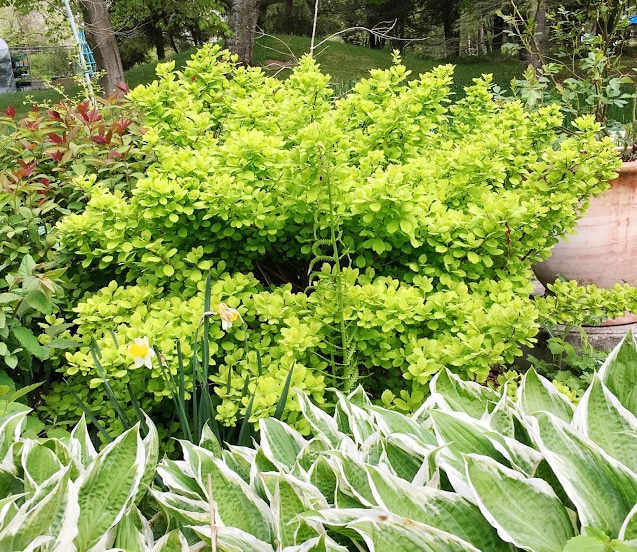
For starters, birchleaf spirea—and in particular ‘Tor Gold’ (aka Glow Girl)—flushes out in spring with bright chartreuse foliage, the very color of spring. The effect is even better thanks to the small, oval leaves with just a touch of serration at their tips. Buds swell to red and pink and color, and with time, they develop lovely frothy white flowers that hang around for weeks. Some birchleaf spireas have darker green foliage.
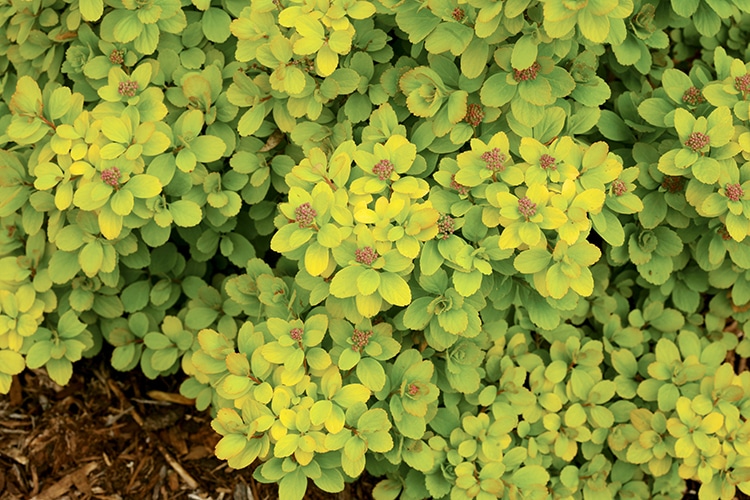
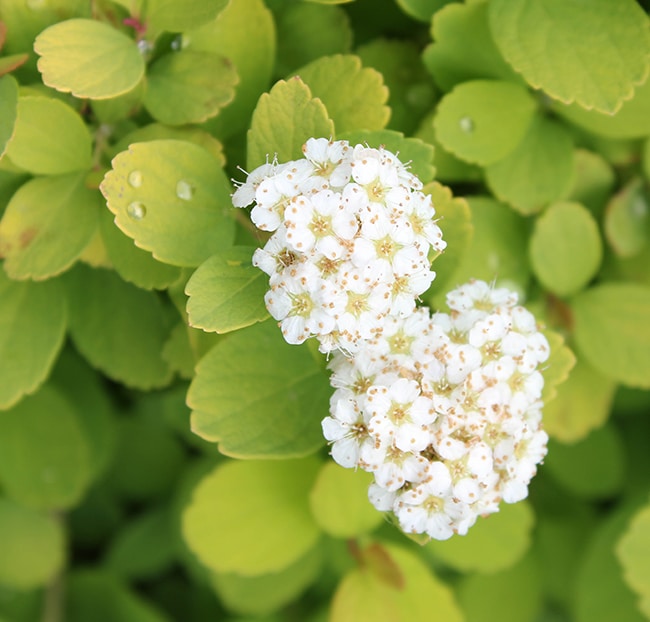
But to me, their best season is fall, when that lime-green foliage gives way to yellows oranges and reds. Although other spireas provide fall color, no other spirea I grow does so with as much vigor as birchleaf, providing much in the way of aesthetics at this time of year.
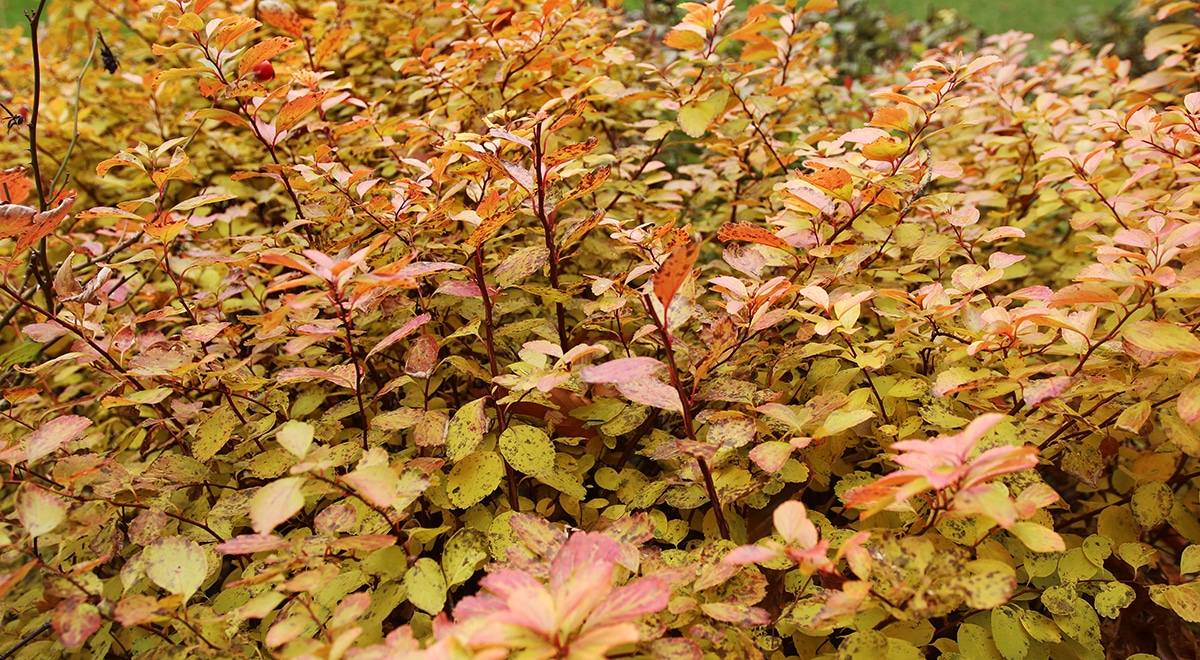
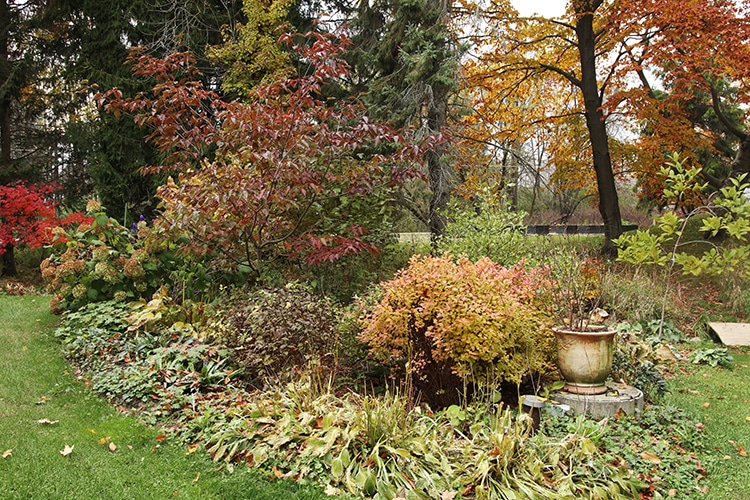
Spireas, of course, are the poster child for low-maintenance plants, which is how they ended up in that maligned landscaper’s trio. In fact their main drawback is a propensity to get bit large and develop bare legs when left to their own devices for too long.
I take a different approaches on the spireas in my yard, often pruning on a whim when I happen to be walking by and decide they need a little shaping. Beware though, you do risk pruning off future flowers if you do this. The “proper” time to prune spireas is right after they flower, but if the blooms are less important than the foliage, you can prune at nearly any time.
Birchleaf spirea has a naturally rounded habit, but if you are a lover of meatball plants, you can prune it a bit more into that shape. Like other spireas, they can get a little bare at the bottom over time. When this starts happening, consider doing a bit of restorative pruning, but taking out a few branches (not more than 25 percent) all the way down to the ground. This will encourage fresh new growth at the bottom to help the shrub fill out. After many years in the ground, my Glow Girl is due for this treatment.
Deer don’t give spireas a single look, which is always worth an extra star in my book and I’ve not found them to be affected much by other bugs or common diseases. They do, however, want to be in at least part sun and, like most plants, you’ll get the best flowering in more sun.
To think, I once considered spirea to be “van ordinaire.” Now I wouldn’t want to be without it.
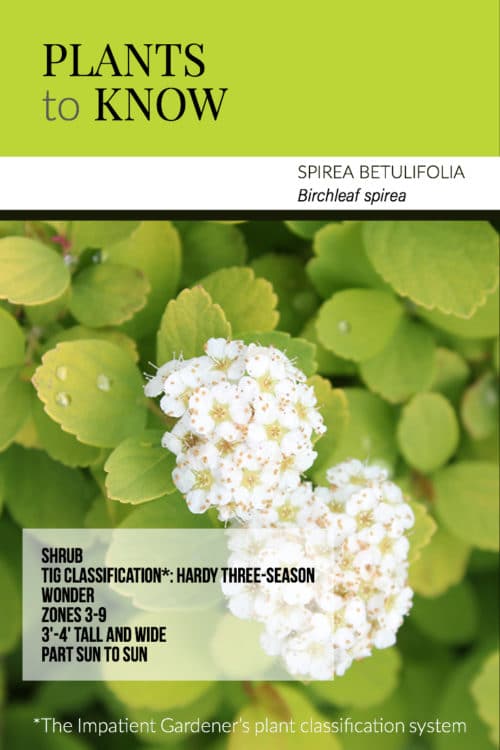


12 Responses
I have a spirea in my garden. It looks good this year, but it does get brown spots on the leaves and we end up having to cut it way back. Is it a sign of heat or water stress? We live in Indiana.
I have a Glow Girl Birchleaf Spirea that is 3 years old. It is doing great, and yes, the fall color is superb! In all my years as a landscaper, we always pruned spirea down in the spring and cleaned out the center crown to refresh. I am wondering if this is a good practice with this Birchleaf type?
ERIN: You are so fortunate to be able to enjoy spireas and hostas in your garden without the deer consuming them to the ground, That is what happened in my garden. Right now all my spireas look like deciduous shrubs in the winter and dead shrubs at this time of the year. Upon close inspection, however, one can see that tiny new leaves are actually trying to push through. So my spireas are not actually dead yet. But the deer in my area (zone 6 northern NJ) continue to nibble away on the tiny new growth. I am in the processing of digging each spirea out now (big job for I do have many). I am tempted to replace the new gaps in my garden with the new spireas that you write about.
Thank you bringing them to my attention. Your blog is most helpful and I enjoy reading it very much.
Lovely shrub that Glow Girl, but what I really want to know is how pleased or disappointed you may be with the blue color of the Blue Kazoo spirea!? Currently planning two areas with the Blue Kazoo in mind. One is a strip that sits between two walkways, the upper side is seen from the house and the lower from a landscape area before the pastures begin and about 6 would do. Thinking about a backdrop of Cornus behind the Blue Kazoo, that will peak over the top to see from the house in winter. However, if the Blue Kazoo is as good as the promo pictures. Then I may find other plantings for color and texture play to situate on both sides and forget the Cornus. My thought, was to plant one of the orange varieties of Cornus such as Anny’s Winter Orange or Midwinter Fire behind it where that glowing orange color will be seen in winter poking above the bare Kazoo, but what about summer? It will probably look a bit ordinary from the lower path? I purchased a half dozen DBL Play Gold for a bright backdrop to be seen through a small grove of quaking aspen from the house, but they have been poor performers, and the color flower sets my teeth on edge, its just off and a hard color to work with. The Goldmound w/pink is striking and hues balanced. A pair of Goldmound, you walk between from the drive, is spectacular with a swath of lavender flowering subulata moss, and this year added Johnson’s Blue in front of the other with the same moss, which is such a striking combination in any light when in bloom against the lime color. I love the way our gardens keep evolving and how they bring us so much joy and pleasure. I am in the mountains of VA and a micro zone 5. Its a challenge. We have sideways snow, ice, rain. This spring I thought I lost three ginkos, and several Japanese Maples, but new leaves are just now appearing. My “project” dubbed the Gan Eden, is like canvas waiting to be finished. Enjoyed your site, back to weeding. LOL
I have Golden Thumbelina which is 15 years old. Love the bright foliage but the flowers are pink. Ugh. I will have to check this one out. I like the look of the white flowers much more.
Yes, some of the pink flowers on some spirea are well, challenging.
I have always seen spirea used in grocery store and fast food restaurant parking lots around here so that is probably why I haven’t given them much thought for my own garden. But it looks so pretty in yours that I can see new possibilities. This fall particularly, the shrubs were the stars of the show so I have been considering adding some more next season.
This was my experience exactly. Generally speaking, if I see a plant in a big box parking lot, it’s usually not at the top of my list. More and more, I want more shrubs in my garden!
I planted spirea 15 years ago and I still love them. Mine bloom pink.
I absolutely agree with you. I thought Spirea grew big, had white blooms in spring, and that was it. When we moved to this brand new house last year, I was pleasantly surprised to find so many low growing colorful spireas that bloomed pink and white. You are right– not even a nibble from the deer. I think you could put them in the category of boxwood that are also never touched by deer. I have found some other surprises in the plant world as well. I have been gardening over 50 years and it is amazing to me how many new plants are sold now. It certainly helps me plant a new garden in a deer area.
It is pretty amazing how many new plants come on the market. Some great improvements, but some of the old-fashioned cultivars have lovely qualities too. The deer resistance is so important!